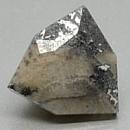|
ClassicGems.net |
|
|
 |
| Tellurium (Native) |
|
|
Discovered in 1783; IMA status: Valid (pre-IMA; Grandfathered) |
|
|
|
Chemistry |
|
|
| |
|
Te | |
|
|
Elemental Tellurium |
|
Atomic Number: |
52 |
|
Molecular Weight: |
127.60 gm |
|
Composition: |
Tellurium |
100.00 % |
Te |
|
|
|
|
|
100.00 % |
|
|
|
|
|
|
||||
|
Classification |
|
|
| |
|
Elements | |
|
1/B.03-40 | |
|
|
1 : ELEMENTS (Metals and intermetallic alloys; metalloids and nonmetals; carbides, silicides, nitrides, phosphides)
|
|
Related to: |
Selenium Group. |
|
Members of Group: |
Selenium Group: Selenium, Tellurium |
|
Varieties: |
Selen-tellurium |
|
Synonyms: |
Lionite (of Berdell), Native Tellurium, Sylvanite (of Kirwan) |
|
|
|
|
Crystal Data |
|
|
|
|
|
Crystals, to 3.5 cm, prismatic and acicular || [0001] with (+) and (–) rhombohedra equally developed; also massive, columnar to fine granular. |
|
|
None |
|
|
|
|
|
Physical Properties |
|
|
|
|
|
Perfect on {1010}, imperfect on {0001} |
|
|
n/a |
|
|
Brittle |
|
|
2.0 - 2.5; Vickers: VHN100=48-66 kg/mm2 |
|
|
10.58 (g/cm3) |
|
|
None |
|
|
Not Radioactive |
|
|
|
|
|
Optical Properties |
|
|
|
|
|
Tin-white; in polished section, white |
|
|
Opaque |
|
|
Metallic |
|
|
R1–R2: (400) 58.1–64.2, (420) 58.4–64.8, (440) 58.7–65.3, (460) 59.1–65.7, (480) 59.3–66.1, (500) 59.7–66.5, (520) 60.0–66.8, (540) 60.1–67.0, (560) 60.2–66.8, (580) 60.0–66.6, (600) 59.5–66.0, (620) 58.8–65.2, (640) 57.9–64.3, (660) 57.1–63.4, (680) 56.1–62.3, (700) 55.0–61.3 |
|
|
0.000 (opaque) |
|
|
None |
|
|
Feeble |
|
|
Fairly strong; color in reflected light: white |
|
|
|
|
|
Occurances |
|
|
|
|
|
Geological Setting: |
In hydrothermal veins; may be of both primary and secondary origin; a sublimate in volcanic fumaroles. |
|
Common Associations: |
Gold, Sylvanite, Empressite, Altaite, Pyrite, Galena, Alabandite, Barite, Quartz, Carbonates. |
|
Common Impurities: |
Se, Fe, Bi, S |
|
Type Locality: |
Mariahilf Mine, Faţa Băii (Facebánya; Facebay; Fatiabaja), Zlatna (Zalatna; Zalathna), Alba County, Romania |
|
Year Discovered: |
1783 |
|
View mineral photos: | |
|
|
|
|
Unusual Gem Categories |
|
|
|
|
|
|
Metallic Gems, Native Elements |
|
|
|
|
More Information |
|
|
|
|
|
| |
|
|
|
|
Tellurium is a chemical element similar to Copper, Silver and Gold. Crystalline Tellurium has a silvery-white appearance with a metallic lustre when pure. It resists oxidation by air and is nonvolatile. Tellurium is mildly toxic and people exposed to even very small amounts of it in air, develop "tellurium breath", which has a garlic-like odor. Tellurium is one of the rarest stable solid elements in the Earth's crust with an abundance comparable to that of Platinum. The picture above is a gem of Quartz matrix with bright, metallic native Tellurium crystals from the Bambolla Mine, Moctezuma, Mun. de Moctezuma, Sonora, Mexico. Native Tellurium is often associated with white to yellow Tellurite and grayish-white to creamy yellow Paratellurite which are both Tellurium Oxide minerals. Tellurium was discovered in 1783 by Australian mineralogist Baron Franz Joseph Müller von Reichenstein (1740 or 1742-1825 or 1826) in Gold ore samples from the Mariahilf Mine, Fata Băii, Zlatna, Transylvania, Romania. Müller isolated an unknown metal from the samples but after three years and more than fifty tests he could not identify it. Apparently in frustration, he gave it the names aurum paradoxium and metallum problematicum. Müller sent a sample to German chemist Martin Heinrich Klaproth (1743-1817) who was able to identify the unknown metal as a new element in 1798. He named it tellurium from the Latin name of planet Earth, tellus, and credited Müller with its discovery. Tellurium distribution: in Romania, from Faţa Bâii (Zlatna, Faczebaj) [TL] and Baia-de-Aries (Offenbánya). At the Fossa volcano, Vulcano, Lipari Islands, Italy. From the Tolbachik fissure volcano, Kamchatka Peninsula, Russia. Large cleavages at the Kochbulak gold deposit, Chatkal-Kuramin Mountains, eastern Uzbekistan. In the USA, from many localities in Colorado, including Cripple Creek, Teller County; in the Magnolia, Gold Hill, Ballarat, and Central districts, Boulder County; and at the Vulcan mine, Gunnison County; in Nevada, at the Mohawk and Clermont mines, Goldfield district, Humboldt County, and from Delamar, Lincoln County At the Moctezuma (Bambolla) mine, 12 km south of Moctezuma, Sonora, Mexico. From the El Indio mine, east of La Serena, Coquimbo, Chile. At Kalgoorlie, Western Australia. In the Teine mine, northwest of Sapporo, Hokkaido, and in the Kawazu mine, near Sizewka, Shizuoka Prefecture, Japan. From the Emperor mine, Vatukoula, Viti Levu, Fiji Islands. At the Guilaizhuang gold deposit, Shandong Province, and in the Dashuigou tellurium deposit, Sichuan Province, China. Additional minor localities are known. |
|
|
Tellurium gems for sale: We have not photographed our Tellurium gems yet. Please check back soon. |